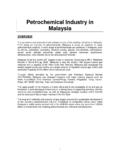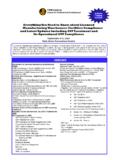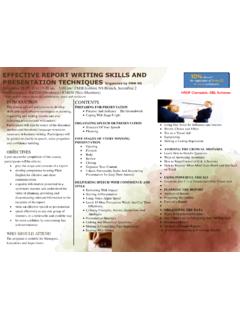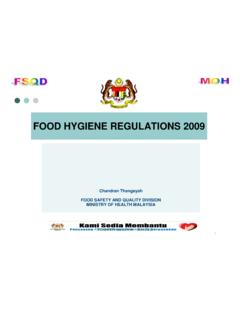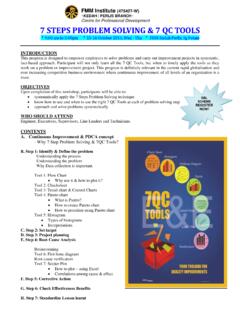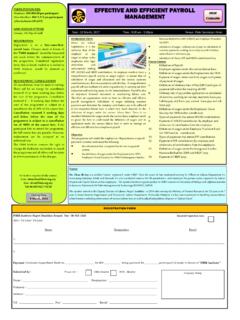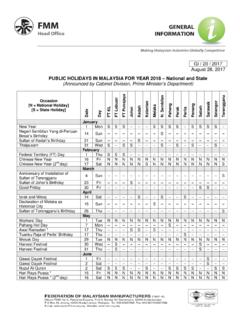Transcription of Petrochemical Industry in Malaysia - FMM
1 1 Petrochemical Industry in Malaysia OVERVIEW The petroleum and petrochemicals Industry is one of the leading industries in Malaysia . From being an importer of petrochemicals, Malaysia is today an exporter of major Petrochemical products. A wide range of petrochemicals are produced in Malaysia , such as olefins, polyolefins, aromatics, ethylene oxides, glycols, oxo-alcohols, exthoxylates, acrylic acids, phthalic anhydride, acetic acid, styrene monomer, polystyrene, ethylbenzene, vinyl chloride monomer and polyvinyl chloride. Malaysia holds the world's 24th largest crude oil reserves. According to BP s Statistical Review of World Energy 2008 , Malaysia is also the world s 14th largest natural gas reserves with a capacity of 88 trillion cubic feet. Besides, Malaysia also possesses the world's largest production facility at a single location of liquefied natural gas (LNG) with production capacity of 23 million metric tonnes per year.
2 Through efforts provided by the government and Petroliam Nasional Berhad ( petronas ), Malaysia has attracted investors and major Industry players such as Shell, ExxonMobil, Dow Chemical, ConocoPhilips, Kaneka, Polyplastic, Toray, Dairen, Mitsui, BP, BASF, Idemitsu, Titan and Eastman Chemicals. The rapid growth of the Industry is mainly attributed to the availability of oil and gas as feedstock, a well-developed infrastructure, a strong base of supporting services, and the country's cost competitiveness, as well as Malaysia 's strategic location within ASEAN and its close proximity to major markets in the Far East. The long term reliability and security of gas supply ensures the sustainable development of the country's Petrochemical Industry . Feedstock at competitive prices have made Malaysia a viable Petrochemical hub in the ASEAN region attracting more than USD$9 billion in investments from leading Petrochemical and chemical manufacturers.
3 2 Production of Petrochemical Feedstocks Petrochemical PRODUCTS CAPACITY (mtpa) COMPANY Naphtha million petronas Penapisan (Terengganu) Sdn Bhd petronas Penapisan (Melaka) Sdn Bhd Malaysia Refinery Company Sdn Bhd Shell Refinery Company (FOM) Bhd Esso ( Malaysia ) Bhd Methane (sales gas) million Ethane Propane Butane Condensate Liquefied Petroleum Gas (LPG) million petronas Gas Berhad Malaysia LNG Tiga Sdn Bhd Ethylene million Titan Petchem (M) Sdn Bhd Ethylene Malaysia Sdn Bhd Optimal Olefins (M) Sdn Bhd Propylene 854 thousand Titan Petchem (M) Sdn Bhd MTBE (M) Sdn Bhd Optimal Olefins (M) Sdn Bhd Benzene, Toulene and Xylene (BTX) 775 thousand Titan Petchem (M) Sdn Bhd Aromatics Malaysia Sdn Bhd {Source: MIDA} 3 Petrochemical Zones in Malaysia Petrochemical Zones Facilities & Infrastructures Products Kertih, Terengganu Gas processing plants Peninsular Gas Utilisation (PGU) project Centralised utility faciltities Institute Technology Petroliam Kertih Port Kuantan Port Praxylene Benzene Ammonia Acetic Acid Ethylene Polyethylene Ethanolamines Ethoxylates Glycol Ethers Butanol Butyl Acetate Ethylene Oxide Ethylene Glycol Low Density Polyethylene Vinyl Chloride Monomer Polyvinyl Choride Gebeng, Pahang Peninsular Gas Utilisation (PGU)
4 Project Centralized utility facilities Kuantan Port Environment Technology Park East Coast Highway Acrylic Acid and Esters Syngas Butyl Acrylate Oxo-alcohols Phthalic Anhydride and Plasticizers Butanediol Tetrahydrofurane Gamma-butyrolastone Polyester Copolymers Purified Terephthalic Acid Dispersion Polyvinyl Chloride Methyl Methacrylates Copolymers MTBE Propylene Polyacetals Polypropylene Polybtylene Terephthalate (PBT) Pasir Gudang - Tanjung Langsat, Johor Peninsular Gas Utilisation (PGU) project Tank farms developed for storage of Petrochemical liquid Johor Port Tanjong Pelepas Port Tanjung Langsat Port Ethylene Propylene BTX Polyethylene Polypropylene High Impact Polystyrene Ethylbenzene Styrene Monomer Expandable Polystyrene Ethylene Vinyl Acetate Bintulu, Sarawak Bintulu Port Bintulu Airport Ammonia Urea LNG Synthetic Gas Oil Synthetic Kerosene Synthetic Naphtha Synthetic Solvents Synthetic Detergent Feedstock Synthetic Paraffin W ax / W axy Raffinate {Source: MIDA} 4 SIGNIFICANT DEVELOPMENTS IN 2010 In 2010, the Malaysian petrochemicals Industry began its recovery, with production surging due to export demand.
5 According to the Ministry of International Trade and Industry , the chemical and Petrochemical Industry is poised for recovery this year based on better overall performance of the economy. Industry players also agreed that this year would be better than 2009 in terms of sales and performance while the Industry expected to see steady growth in 2011, given the rise in global energy demand and economic growth. This is an opportunity for the chemical and Petrochemical Industry to move up the value chain by using high-technology producing high value-added products, and reinventing into knowledge-based and skills-intensive industries. Another proof for expansion in the Petrochemical Industry is the launching of the largest initial public offering (IPO) to date in Malaysia and in South East Asia by petronas Chemicals Group Berhad (PCG) during in November 2010. PCG is the leading integrated petrochemicals producer in Malaysia and one of the largest petrochemicals producers in South East Asia.
6 Their IPO had attracted overwhelming response from both leading domestic and international institutional investors. This not only clearly reflects the investors confidence in the company, but also in the Malaysian Petrochemical Industry . With increased productivity and expansion in Industry output, coupled with world class infrastructure across the value chain, and the integrated Petrochemical zones, the Industry is set for further development and growth. Malaysia continues to attract foreign investment, but the Industry is reassessing its competitive status within the ASEAN and the threat posed by China s rapid industrial expansion. The Petrochemical Industry is facing tougher market conditions with falling product prices, slowing demand growth and a massive increase in capacities in Asia and the Middle East. In order to sustain production volumes, Malaysian producers will need to constrain feedstock costs.
7 In the face of intensified competitiveness in the global market, prospects for the Malaysian petrochemicals Industry depend on its ability to cultivate and maintain competitive advantages over other competing nations. The People s Republic of China is expected to remain the largest market for Malaysia s exports of petrochemicals. There will be considerable potential for the export of higher value-added products, for example, Petrochemical derivatives, to the People s Republic of China. Demand for commodity-type petrochemicals higher value-added products, such as fine and specialty chemicals, from other ASEAN countries from ASEAN countries, especially Cambodia, Lao PDR, Myanmar and Viet Nam, is expected to increase, in tandem with the growth of their economies. Demand for, namely Thailand, Indonesia and the Philippines, is also expected to increase. Malaysia has an advantage in that there are downstream industries using the products produced.
8 Based on the present and future market trends, there is potential to create greater synergies, by increasing Malaysia s share in both the domestic and regional markets for Petrochemical products. To sustain the competitiveness of the Malaysian Petrochemical Industry , value integration through inter-plant synergies is promoted. The development of Petrochemical zones where Petrochemical plants are clustered together has created a value chain, which ensures the progressive development of downstream petrochemicals activities. 5 CHALLENGES a) High Cost of Developing New Petrochemical Zones The establishment of new Petrochemical zones is costly, in view of the high investments required in the provision of dedicated infrastructure facilities, such as ports and CUF, as well as support services. Upstream linkages to a refinery or gas processing plants, including a cracker, will be an advantage to ensure the availability of feedstock.
9 However, the challenge will be to structure the downstream products, which will generate optimum value-added in the utilization of oil and gas resources. b) Competition for Investments and Markets The cyclical nature of the Petrochemical business is a characteristic of the Industry . The Industry will need to overcome short-term and sporadic volatilities in feedstock costs, product prices and low margins, brought about by competition in the global and regional markets, notably from West Asia and other ASEAN producers. Malaysian Petrochemical companies will face increasing competition to gain greater access to the ASEAN markets, as these countries are also developing their own Petrochemical industries. Malaysia will need to increase the volume of production of petrochemicals and provide a more conducive environment to promote investments in a wider range of high value-added products. The Industry is the need to maintain a long-term perspective of the business and build a business portfolio with a range of products, which will sustain its competitiveness throughout the business cycle, improve its cost structure through enhancing supply chain management, develop superior customer-service orientation, with niche market products, and create awareness in the development of environment-friendly products.
10 C) Lack of Synergies and Economies of Scale Main users of petrochemicals, which mostly comprise SMEs, generally lack economies of scale, capital, and technical and marketing expertise to become major producers. There will be a need to encourage consolidation within the Industry , through joint ventures, strategic partnerships and other forms of collaborations with MNCs, to benefit from technology transfers, cost efficiencies and larger markets in areas such as medical devices, automotive parts and biotechnological products. d) Availability and Reliability of Feedstocks The availability and reliability of feedstocks at competitive prices is a key factor for the further development and enhancement of the Industry . Natural gas and condensates, obtained from the gas fields off the coast of Terengganu, are the main raw materials for petrochemicals in Kertih, Terengganu and Gebeng, Pahang. In Pasir Gudang-Tanjung Langsat, Johor, naphtha is the main raw material.

